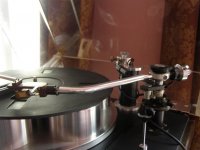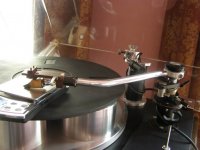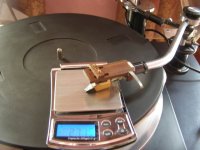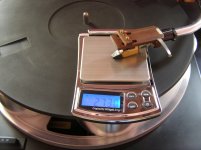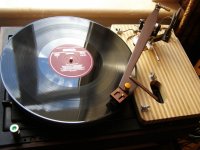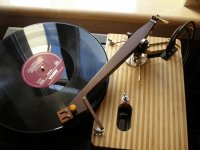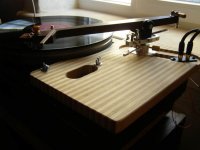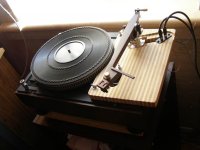Hi,
cell E22 references a blank cell.
This may be an error.
The counterweight does have a significant effect.
That is why a few manufacturers chose tungsten for this component, simply to allow a more compact weight that could be brought closer to the pivot and thus lower the overall effective mass, even though the very high density resulted in a heavier counterweight.
Has anyone seen advertising for an osmium counterweight?
I cannot see why the horizontal moving mass is so much higher than the vertical effective mass.
What am I missing?
cell E22 references a blank cell.
This may be an error.
The counterweight does have a significant effect.
That is why a few manufacturers chose tungsten for this component, simply to allow a more compact weight that could be brought closer to the pivot and thus lower the overall effective mass, even though the very high density resulted in a heavier counterweight.
Has anyone seen advertising for an osmium counterweight?
I cannot see why the horizontal moving mass is so much higher than the vertical effective mass.
What am I missing?
AndrewT said:I cannot see why the horizontal moving mass is so much higher than the vertical effective mass.
What am I missing?
The spreadsheet appears to be for a linear tracking arm. The horizontal moving mass is simply the total mass of the arm.
edit: typo correction
Hi Sy,The counterweight is close to the pivot, maybe a cm or two
I don't think so.
The gap between the counterweight and the bearing housing could be less than 10mm. But then one must add half the housing diameter and the distance to the counterweight CoG from that near face. This COG of counterweight to arm bearing distance could well be 30mm to 60mm.
Effective mass mess
Effective tonearm mass ( E.M.) seems to be very uncertain and messy theme. It would be highly appreciated, if some serious professionals share some light here. There are many tonearms with unknown effective mass, as well as recommended cartridge compliance (not mentioned in manuals). Even in manual on classic SME3009 it is not there.
Question is: how to determine said E.M. of tonearm already owned? Or self-made?
I would guess, that E.M is equal to momentum of inertia. If we accept tonearm mass equal to its weight, than E.M should be equal to it's mass applied on stylus point. So, if we take off tonearm rear section with counterweight (pic. #2), and than measure gravity force applied on stylus point, using stylus force gauge (pic.#2), we should get E.M of tonearm (not counting E.M of rear section with counterweight)? Of course, E.M. together with cartridge, shell and mounting screws. Tonearm here is Micro MA101, and it's E.M. is unknown. Results are: arm+shell+ cart= 27,3g, shell+cart=20,9g, so
Am I on a right path?
Effective tonearm mass ( E.M.) seems to be very uncertain and messy theme. It would be highly appreciated, if some serious professionals share some light here. There are many tonearms with unknown effective mass, as well as recommended cartridge compliance (not mentioned in manuals). Even in manual on classic SME3009 it is not there.
Question is: how to determine said E.M. of tonearm already owned? Or self-made?
I would guess, that E.M is equal to momentum of inertia. If we accept tonearm mass equal to its weight, than E.M should be equal to it's mass applied on stylus point. So, if we take off tonearm rear section with counterweight (pic. #2), and than measure gravity force applied on stylus point, using stylus force gauge (pic.#2), we should get E.M of tonearm (not counting E.M of rear section with counterweight)? Of course, E.M. together with cartridge, shell and mounting screws. Tonearm here is Micro MA101, and it's E.M. is unknown. Results are: arm+shell+ cart= 27,3g, shell+cart=20,9g, so
Am I on a right path?
Attachments
Last edited:
My understanding is that effective mass is the integral of 'mass x distance from pivot', divided by 'distance from pivot to stylus'. It is mass rescaled according to distance, but unlike calculating downforce all mass counts as positive.
If you could remove everything beyond the pivot (i.e. the counterweight end), and assume that there is nothing above the pivot (i.e. everything either contributes to downforce or upforce) then measuring the downforce at the stylus would give you approximately half the effective mass. This is because the end you have chopped off must contribute roughly the same weight (but in the opposite direction) in order to get balance, but it adds to effective mass while subtracting from downforce.
If you could remove everything beyond the pivot (i.e. the counterweight end), and assume that there is nothing above the pivot (i.e. everything either contributes to downforce or upforce) then measuring the downforce at the stylus would give you approximately half the effective mass. This is because the end you have chopped off must contribute roughly the same weight (but in the opposite direction) in order to get balance, but it adds to effective mass while subtracting from downforce.
It is hard to calculate the effective mass from weighting the single elements, but it is more accurate to calculate the effective mass from:
Fres=1/{2*Pi*SQRT[C*(m+M)]}.
Fres is the resonance frequency of your arm including element, C the compliance of the cantilever suspension, m the effective mass of the cartridge and M the effective mass of the arm.
m and M in Kilograms and C in meter/Newton.
As an example: suppose m=10 gram, M=5 gram and C is 15um/mN, then Fres is 10.6 Hz.
The resonance frequency can be measured with a test LP, and should be between 9 and 12 Hz.
11Hz seems to be the optimum according to several publications.
Hans
Fres=1/{2*Pi*SQRT[C*(m+M)]}.
Fres is the resonance frequency of your arm including element, C the compliance of the cantilever suspension, m the effective mass of the cartridge and M the effective mass of the arm.
m and M in Kilograms and C in meter/Newton.
As an example: suppose m=10 gram, M=5 gram and C is 15um/mN, then Fres is 10.6 Hz.
The resonance frequency can be measured with a test LP, and should be between 9 and 12 Hz.
11Hz seems to be the optimum according to several publications.
Hans
My understanding is that effective mass is the integral of 'mass x distance from pivot', divided by 'distance from pivot to stylus'. It is mass rescaled according to distance, but unlike calculating downforce all mass counts as positive.
If you could remove everything beyond the pivot (i.e. the counterweight end), and assume that there is nothing above the pivot (i.e. everything either contributes to downforce or upforce) then measuring the downforce at the stylus would give you approximately half the effective mass. This is because the end you have chopped off must contribute roughly the same weight (but in the opposite direction) in order to get balance, but it adds to effective mass while subtracting from downforce.
Effective mass has everything to do with inertia and much less with real mass.
You can perfectly balance the stylus pressure with a counterweight that has half the mass and is positioned twice as far from the pivot point.
But inertia would be twice as high, because I=R^2*M, resulting in an effective mass that is almost twice as high.
Hans
Now to calculate effective mass.
Calculating a tonearms effective mass is theoretically simple but can be difficult and laborious.
To calculate the vertical effective mass first divide the arm into sections. A larger number of smaller sections will give a more accurate result. For example divide the arm tube into 5mm long sections. Calculate the mass of each section. This is done by calculating the volume of each section and multiplying this by the density of the material it is made from. This can be very difficult for commercial arms as you will probably not know the exact material, and its density. Nor will wall thickness of tubular sections be readable apparent. For diy arms this is much easier as you should know what you are making your arm from.
Next calculate where the centre of mass of each section is and measure/calculate the distance from this to the vertical pivot point. This has bo be a straight line distance, the height above/below the pivot as well as the horizontal distance is important. So a bit of Pythagoras will be needed.
Next SQUARE this distance and multiple by the sections mass. Do this for every section. A spread sheet will be your friend here. Then add the results for all the sections together. I find that doing this in named segments makes this easier, eg headshell, arm tube, counterweight.
Now divide this total by the straight line distance from the vertical pivot to the stylus SQUARED. Again the vertical hight of the pivot is important, a bit more Pythagoras.
This is your vertical effective mass....Almost.
A couple of additional points.
Do not attempt to model the counterweight as a single section as this will give a very inaccurate result. With a typical underslung weight the top front edge will be quite close to the pivot and the bottom rear quite far away. The weight should be divided into sections vertically as well as horizontally. Even with a simple shape like a circular disc the maths can get a bit involved but is not complicated, high school level. For those with a bit of calculus under their belts it is relatively easy to integrate for the whole weight.
Make sure you account for all the components that move in the vertical plain. Eg mounting hardware, finger lift, cartridge tags etc.
Normally the mass of the cartridge is just added to the effective mass of the arm. This is not entirely accurate. Ideally the effect of the cartridges mass should be calculated from its centre of mass which is normally about 10mm above and 10mm behind the stylus. With long arms just adding the mass of the cartridge to the arms effective mass gives a pretty good answer. With short arms, as found on many linear trackers, the cartridges centre of mass must be used to determine its contribution to overall effect mass. Failing to do so can easily result in an error of several grams.
We tend to call the point the arm pivots around the pivot point. In reality it is not a point but a line and is more accurately called the pivot axis. Many arms have a vertical pivot axis that is twisted horizontally to be perpendicular to the offset angle, eg Rega and SME. When calculating the vertical effective mass of an arm with an offset pivot axis the horizontal distances to a section need to be measured at right angles from this axis and NOT from the centre of the armtube between the bearings. For instance, take a 9" tonearm with the vertical pivot axis level with the record surface and offset by 22°. The effective arm length will be 223mm. However the distance from the stylus to the pivot axis is only 207mm. This makes calculating the vertical effective mass of arms with offset bearings a bit more tricky.
Calculating the horizontal or lateral effective mass of the arm is basically the same as for the vertical. Again divide the arm into sections and ascertain mass and centre of mass and distance to the vertical axis. If calculating for an arm with a standard yoked bearing remember to add all the components that only rotate horizontally that were not included in the vertical model eg the bearings yoke.
Calculating the horizontal effective mass of a linear tracking arm is easy, it's just the mass of the arm.
Ideally the determination of the effective mass of the arm should be done as part of the entire design from the start and not as an afterthought. It is relatively easy to add extra features to the spread sheet used to calculate effective mass. Using these you can tune the design of your arm to ideally match your chosen cartridge. As you should know your cartridges compliance you can determine the cantilever resonance. If you have set up your spread sheet neatly you should easily be able to add in calculations to determine tracking force. Then by adjusting the position and size of the counterweight you can fine tune your design so that when the correct tracking force is set the effective mass will be perfect.
I hope that this is useful. I know that a couple of diagrams would have helped but I sent this from my phone and creating diagrams on this device is a pig.
Niffy.
Calculating a tonearms effective mass is theoretically simple but can be difficult and laborious.
To calculate the vertical effective mass first divide the arm into sections. A larger number of smaller sections will give a more accurate result. For example divide the arm tube into 5mm long sections. Calculate the mass of each section. This is done by calculating the volume of each section and multiplying this by the density of the material it is made from. This can be very difficult for commercial arms as you will probably not know the exact material, and its density. Nor will wall thickness of tubular sections be readable apparent. For diy arms this is much easier as you should know what you are making your arm from.
Next calculate where the centre of mass of each section is and measure/calculate the distance from this to the vertical pivot point. This has bo be a straight line distance, the height above/below the pivot as well as the horizontal distance is important. So a bit of Pythagoras will be needed.
Next SQUARE this distance and multiple by the sections mass. Do this for every section. A spread sheet will be your friend here. Then add the results for all the sections together. I find that doing this in named segments makes this easier, eg headshell, arm tube, counterweight.
Now divide this total by the straight line distance from the vertical pivot to the stylus SQUARED. Again the vertical hight of the pivot is important, a bit more Pythagoras.
This is your vertical effective mass....Almost.
A couple of additional points.
Do not attempt to model the counterweight as a single section as this will give a very inaccurate result. With a typical underslung weight the top front edge will be quite close to the pivot and the bottom rear quite far away. The weight should be divided into sections vertically as well as horizontally. Even with a simple shape like a circular disc the maths can get a bit involved but is not complicated, high school level. For those with a bit of calculus under their belts it is relatively easy to integrate for the whole weight.
Make sure you account for all the components that move in the vertical plain. Eg mounting hardware, finger lift, cartridge tags etc.
Normally the mass of the cartridge is just added to the effective mass of the arm. This is not entirely accurate. Ideally the effect of the cartridges mass should be calculated from its centre of mass which is normally about 10mm above and 10mm behind the stylus. With long arms just adding the mass of the cartridge to the arms effective mass gives a pretty good answer. With short arms, as found on many linear trackers, the cartridges centre of mass must be used to determine its contribution to overall effect mass. Failing to do so can easily result in an error of several grams.
We tend to call the point the arm pivots around the pivot point. In reality it is not a point but a line and is more accurately called the pivot axis. Many arms have a vertical pivot axis that is twisted horizontally to be perpendicular to the offset angle, eg Rega and SME. When calculating the vertical effective mass of an arm with an offset pivot axis the horizontal distances to a section need to be measured at right angles from this axis and NOT from the centre of the armtube between the bearings. For instance, take a 9" tonearm with the vertical pivot axis level with the record surface and offset by 22°. The effective arm length will be 223mm. However the distance from the stylus to the pivot axis is only 207mm. This makes calculating the vertical effective mass of arms with offset bearings a bit more tricky.
Calculating the horizontal or lateral effective mass of the arm is basically the same as for the vertical. Again divide the arm into sections and ascertain mass and centre of mass and distance to the vertical axis. If calculating for an arm with a standard yoked bearing remember to add all the components that only rotate horizontally that were not included in the vertical model eg the bearings yoke.
Calculating the horizontal effective mass of a linear tracking arm is easy, it's just the mass of the arm.
Ideally the determination of the effective mass of the arm should be done as part of the entire design from the start and not as an afterthought. It is relatively easy to add extra features to the spread sheet used to calculate effective mass. Using these you can tune the design of your arm to ideally match your chosen cartridge. As you should know your cartridges compliance you can determine the cantilever resonance. If you have set up your spread sheet neatly you should easily be able to add in calculations to determine tracking force. Then by adjusting the position and size of the counterweight you can fine tune your design so that when the correct tracking force is set the effective mass will be perfect.
I hope that this is useful. I know that a couple of diagrams would have helped but I sent this from my phone and creating diagrams on this device is a pig.
Niffy.
That is as I expected it to be. If I knew effective mass of my Micro arm, it would be easily possible to check this by experiment with gauge, and compare final result with already known numbers (it's rear section entirely comes off).My understanding is that effective mass is the integral of 'mass x distance from pivot', divided by 'distance from pivot to stylus'. It is mass rescaled according to distance, but unlike calculating downforce all mass counts as positive.
If you could remove everything beyond the pivot (i.e. the counterweight end), and assume that there is nothing above the pivot (i.e. everything either contributes to downforce or upforce) then measuring the downforce at the stylus would give you approximately half the effective mass. This is because the end you have chopped off must contribute roughly the same weight (but in the opposite direction) in order to get balance, but it adds to effective mass while subtracting from downforce.
If that method works, it gives us pretty simple way to find E.M. of any arm, without disassemblying it, as well, as without using test record and complicated maths.Unfortunately, all three arms I possess do not have E.M. data nor in manuals, nor in datasheet. So, I'm not able to perform that experiment.
Thank you for detailed reply. Unfortunately, in many cases dividing it into sections would be too complicated, especially with arms of complicated shapes and sandwich like or composite structures.Calculating a tonearms effective mass is theoretically simple but can be difficult and laborious.
To calculate the vertical effective mass first divide the arm into sections. A larger number of smaller sections will give a more accurate result. For example divide the arm tube into 5mm long sections. Calculate the mass of each section. This is done by calculating the volume of each section and multiplying this by the density of the material it is made from. This can be very difficult for commercial arms as you will probably not know the exact material, and its density. Nor will wall thickness of tubular sections be readable apparent. For diy arms this is much easier as you should know what you are making your arm from.
Next calculate where the centre of mass of each section is and measure/calculate the distance from this to the vertical pivot point. This has bo be a straight line distance, the height above/below the pivot as well as the horizontal distance is important. So a bit of Pythagoras will be needed.
Normally the mass of the cartridge is just added to the effective mass of the arm.
Niffy.
In my case, beside Micro MA101, I need to calculate E.M. for rather unusual arm with spring "counterweight".
Attachments
Last edited:
Niffy,
it is perfectly clear what you mean.
To support your explanation, it might help to give a simplified example.
Suppose that a fictive element, weighting 10 gram, is just concentrated in a point, also including the needle, sitting at the end of a weightless armtube, 200mm from the pivot point.
The math I1=R^2*M is in that case 200^2*10=400.000.
Let's assume needle pressure has to be 2 gram.
That means that the remaining 8 gram * 200mm has to be compensated by a counterweight with the same product of Distance*Weight.
Now suppose the mass of the counterweight at the other end is also concentrated in a single point, weighting 100gram at a distance 16mm from the pivot point.
Now I2 will be 16^2*100=25.600.
I1 and I2 added together and divided by the square of the distance from stylus to pivot gives (I1+I2)/(200^2)= 10.6 gram being the effective mass.
Hopes this adds to understanding Niffy explanation.
Hans
it is perfectly clear what you mean.
To support your explanation, it might help to give a simplified example.
Suppose that a fictive element, weighting 10 gram, is just concentrated in a point, also including the needle, sitting at the end of a weightless armtube, 200mm from the pivot point.
The math I1=R^2*M is in that case 200^2*10=400.000.
Let's assume needle pressure has to be 2 gram.
That means that the remaining 8 gram * 200mm has to be compensated by a counterweight with the same product of Distance*Weight.
Now suppose the mass of the counterweight at the other end is also concentrated in a single point, weighting 100gram at a distance 16mm from the pivot point.
Now I2 will be 16^2*100=25.600.
I1 and I2 added together and divided by the square of the distance from stylus to pivot gives (I1+I2)/(200^2)= 10.6 gram being the effective mass.
Hopes this adds to understanding Niffy explanation.
Hans
It seems I was wrong. Sorry to mislead people. It is a long time since I studied classical mechanics!DF96 said:My understanding is that effective mass is the integral of 'mass x distance from pivot', divided by 'distance from pivot to stylus'. It is mass rescaled according to distance, but unlike calculating downforce all mass counts as positive.
What I should have said is
My understanding is that effective mass is the integral of 'mass x (distance^2) from pivot', divided by '(distance from pivot to stylus)^2'. It is mass rescaled according to distance^2, but unlike calculating downforce all mass counts as positive.
My thanks to those who corrected me.
Hi walterwalter.
What a beautifully crafted arm, the finish quality is exemplary.
My arm is quite a complicated laminated design. I calculated the effective mass contribution for each laminated then summed them all. As I divided the arm into 1mm sections I did end up with hundreds of individual sections and a very accurate effective mass calculation. However this was part of a much larger spread sheet that calculated not only effective mass, cantilever resonance and tracking force but also resonant frequency of arm (vertically and laterally), tracking force variations due to warps and warp wow. This was all part of the design stage and was performed before any sawdust was made. As my arm is a linear tracker I only calculated vertical effective mass. I would hate to have to reverse engineer this for an existing arm. Also I have not investigated spring tracking force adjustment. I assume that the tracking force spring, having its own compliance, would have a separate effective mass/compliance resonance that would need to be at a similar frequency to the cantilever resonance. But as I said I haven't studied this type of arm so I may be missing something.
Unfortunately there are no shortcuts to calculating effective mass. The easiest way for an existing arm is to use a test record.
Niffy
What a beautifully crafted arm, the finish quality is exemplary.
My arm is quite a complicated laminated design. I calculated the effective mass contribution for each laminated then summed them all. As I divided the arm into 1mm sections I did end up with hundreds of individual sections and a very accurate effective mass calculation. However this was part of a much larger spread sheet that calculated not only effective mass, cantilever resonance and tracking force but also resonant frequency of arm (vertically and laterally), tracking force variations due to warps and warp wow. This was all part of the design stage and was performed before any sawdust was made. As my arm is a linear tracker I only calculated vertical effective mass. I would hate to have to reverse engineer this for an existing arm. Also I have not investigated spring tracking force adjustment. I assume that the tracking force spring, having its own compliance, would have a separate effective mass/compliance resonance that would need to be at a similar frequency to the cantilever resonance. But as I said I haven't studied this type of arm so I may be missing something.
Unfortunately there are no shortcuts to calculating effective mass. The easiest way for an existing arm is to use a test record.
Niffy
The Moment of Inertia (or second moment of area) can be calculated for any shape.
But if you move that shape such that the point of rotation is some distance from the centre of gravity, then you have to change the MoI by ADDING on the translation Moment of Inertia.
eg.
A cuboid has a MoI given by B² * D² /12 and the mass inertia is simply obtained by multiplying by m (the mass in kilograms).
Mass inertia is m*B²*D²/12
If one moves that mass away from the centre of rotation then one adds on the MoI for the translation (as given by HansP) translation MoI=m X²
The total MoI is m*[(B²* D²)/12 + X²]
If X is small relative to B & D, then both terms can be signficant.
If X is very much bigger than B & D, then the translation MoI is much bigger than the centroid based shape MoI and the shape MoI can often be ignored if an approximation is good enough.
HansP has ignored the shape MoI and only accounted for the translation MoI.
https://en.wikipedia.org/wiki/List_of_moments_of_inertia
https://en.wikipedia.org/wiki/Parallel_axis_theorem
https://en.wikipedia.org/wiki/Second_moment_of_area
But if you move that shape such that the point of rotation is some distance from the centre of gravity, then you have to change the MoI by ADDING on the translation Moment of Inertia.
eg.
A cuboid has a MoI given by B² * D² /12 and the mass inertia is simply obtained by multiplying by m (the mass in kilograms).
Mass inertia is m*B²*D²/12
If one moves that mass away from the centre of rotation then one adds on the MoI for the translation (as given by HansP) translation MoI=m X²
The total MoI is m*[(B²* D²)/12 + X²]
If X is small relative to B & D, then both terms can be signficant.
If X is very much bigger than B & D, then the translation MoI is much bigger than the centroid based shape MoI and the shape MoI can often be ignored if an approximation is good enough.
HansP has ignored the shape MoI and only accounted for the translation MoI.
https://en.wikipedia.org/wiki/List_of_moments_of_inertia
https://en.wikipedia.org/wiki/Parallel_axis_theorem
https://en.wikipedia.org/wiki/Second_moment_of_area
Last edited:
Thank you Nyffy. Arm type, I'm experimenting with, behaves very differently from traditional ones, it resonates differently, it tracks differently, and becomes almost immune to outside vibrations and rumble ( amaizingly, rumble level drops 10 to 30 dB down, if counterweigh on the same arm is substituted with spring). The most inportant is the absence of gravitational counterweight. In my case it is spring loaded. Tracking force spring is not crucial, if counterweight still present.Hi walterwalter.
What a beautifully crafted arm, the finish quality is exemplary.
Also I have not investigated spring tracking force adjustment. I assume that the tracking force spring, having its own compliance, would have a separate effective mass/compliance resonance that would need to be at a similar frequency to the cantilever resonance. But as I said I haven't studied this type of arm so I may be missing something.
Niffy
- Status
- This old topic is closed. If you want to reopen this topic, contact a moderator using the "Report Post" button.
- Home
- Source & Line
- Analogue Source
- effective mass
